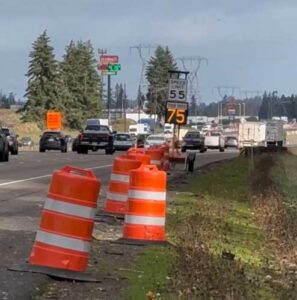Worker safety is in your hands
Orange cones, flashing signs and lane closures are more than just an inconvenience, they’re a warning. Slow down, pay attention and protect the people working just feet from traffic.
Work zone safety doesn’t rely on enforcement alone. While law enforcement partners patrol construction areas when staffing allows, safety begins with every driver who passes through.
“Even when an officer is present, they may be called away to an emergency elsewhere,” said Mindy McCartt, ODOT Public Information Officer “We can’t station a trooper at every project, every hour of the day. That’s why driver behavior is critical.”
In Oregon, fines double in work zones, but the real penalty isn’t measured in dollars — it’s measured in lives. Each year, crashes in work zones result in injuries and fatalities to both workers and drivers.
ODOT budgets for extra law enforcement presence in major construction zones, but safety is still in the hands of the traveling public. “Drivers have the most power to prevent crashes,” said A.J. Jacobson, Resident Engineer – Consultant Project Manager “If you slow down, put the phone away and stay alert, you’re protecting yourself, our crews and our law enforcement partners.”
Major I-5 work zones this season
Drivers should expect reduced speeds, lane closures and crews on the road in these areas:
- I-5 Widening Project: Kuebler Boulevard to Delaney Road (mileposts 249–248, south of Salem) – Crews are widening and paving the southbound lanes to improve capacity and traffic flow.
- Aurora-Donald Interchange Phase 2 (Exit 278): Work is underway to build a diverging diamond interchange to reduce congestion and improve safety at this busy interchange.
Law enforcement may patrol these work zones when available, but ODOT emphasizes that safety is in the hands of every driver who passes through.
Tips for staying safe in work zones:
- Slow down. Speeds are reduced for a reason.
- Stay alert. Watch for workers, equipment and sudden stops.
- Give space. Leave room between your car and the one in front of you.
- Expect delays. Plan ahead and give yourself extra travel time.
“Work zones are temporary, but the decisions you make behind the wheel can last a lifetime,” said Mindy McCartt.
Want to know what it’s really like in a work zone? Our Work Zone Safety Flickr album shows just how close crews are to fast-moving traffic.
Know Before You Go
For 24/7 road conditions and traffic alerts, visit TripCheck.com or call 5-1-1.
Information provided by Oregon Department of Transportation
